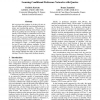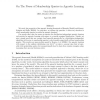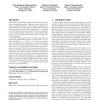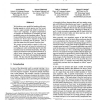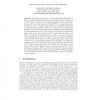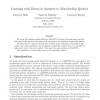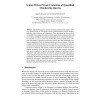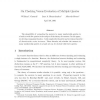134
Voted
INFOCOM
2012
IEEE
13 years 3 months ago
2012
IEEE
—Counting Bloom Filters (CBFs) are widely used in networking device algorithms. They implement fast set representations to support membership queries with limited error, and supp...
108
Voted
AI
2010
Springer
15 years 28 days ago
2010
Springer
We investigate the problem of eliciting CP-nets in the well-known model of exact learning with equivalence and membership queries. The goal is to identify a preference ordering wi...
103
Voted
COLT
2008
Springer
15 years 2 months ago
2008
Springer
We study the properties of the agnostic learning framework of Haussler [Hau92] and Kearns, Schapire and Sellie [KSS94]. In particular, we address the question: is there any situat...
126
Voted
CCS
2008
ACM
15 years 2 months ago
2008
ACM
Hash tables are fundamental data structures that optimally answer membership queries. Suppose a client stores n elements in a hash table that is outsourced at a remote server so t...
COLT
1995
Springer
15 years 4 months ago
1995
Springer
We introduce a new model for learning with membership queries in which queries near the boundary of a target concept may receive incorrect or “don’t care” responses. In part...
119
Voted
ALT
1995
Springer
15 years 4 months ago
1995
Springer
This paper characterizes the polynomial time learnability of TPk, the class of collections of at most k
rst-order terms. A collection in TPk de
nes the union of the languages de
n...
FOCS
2004
IEEE
15 years 4 months ago
2004
IEEE
We study the learning models defined in [AKST97]: Learning with equivalence and limited membership queries and learning with equivalence and malicious membership queries. We show ...
97
Voted
ACNS
2006
Springer
15 years 4 months ago
2006
Springer
Abstract. Membership queries are basic predicate operations that apply to datasets. Quantifications of such queries express global properties between datasets, including subset inc...
MFCS
1990
Springer
15 years 4 months ago
1990
Springer
The plausibility of computing the answers to many membership queries to a hard set with few queries is the subject of the theory of terseness. In this paper, we develop companion ...
119
Voted
ICALP
2001
Springer
15 years 5 months ago
2001
Springer
We consider a model of learning Boolean functions from quantum membership queries. This model was studied in [26], where it was shown that any class of Boolean functions which is i...

